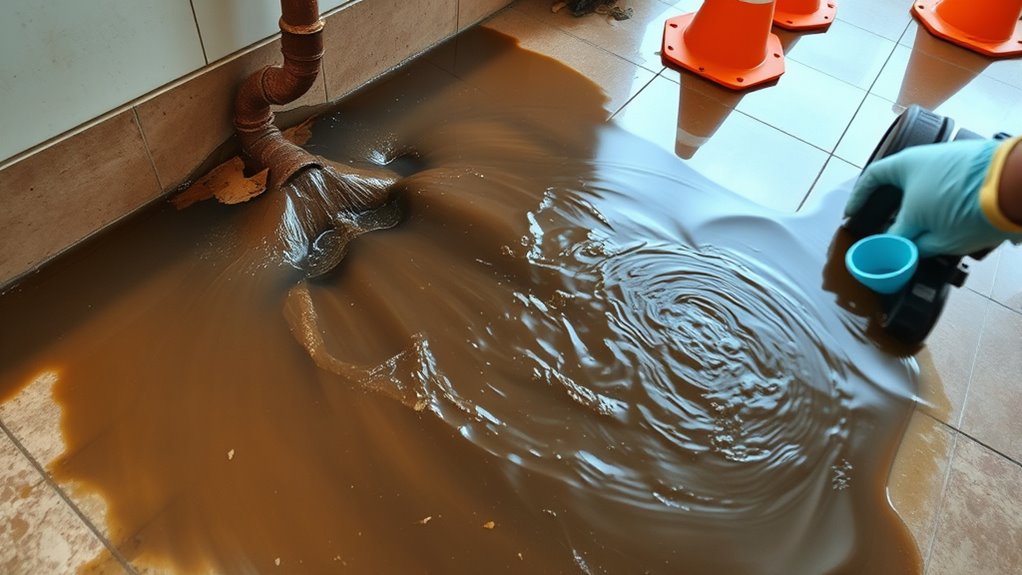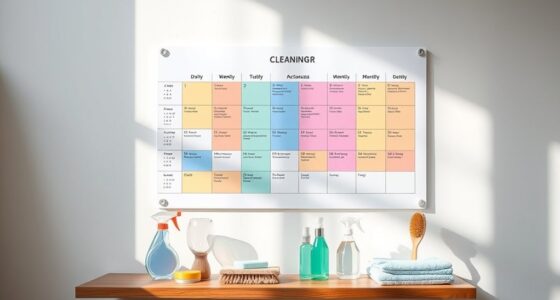When sewage backflow occurs, turn off the main water supply to stop additional sewage from entering your home. Avoid direct contact with contaminated water and wear protective gear like gloves and boots when cleaning. Ventilate the area and disinfect all surfaces that contact sewage with a bleach solution. Isolate the affected zone and check plumbing components like sump pumps. Taking these immediate steps helps protect your health; continue exploring for detailed cleanup and prevention tips.
Key Takeaways
- Turn off the main water supply to prevent further sewage entry.
- Wear protective gear like gloves and boots before handling contaminated items.
- Ventilate the area to reduce airborne contaminants and odors.
- Disinfect all surfaces and objects that came into contact with sewage using bleach or disinfectant.
- Isolate the affected area and inspect or repair backflow prevention devices to stop future backflow.

Have you ever wondered what happens when sewage flows back into your home? It’s a situation that can be both alarming and dangerous. Sewage backflow introduces contaminated water filled with bacteria, viruses, and other pathogens into your living space, posing serious health hazards. The moment you notice the backflow, your first priority should be safety. Turn off the main water supply immediately to prevent more sewage from entering your home. Avoid coming into direct contact with the contaminated water, as it can transmit illnesses such as hepatitis, cholera, or gastrointestinal infections. Wearing rubber gloves and boots can help protect you if you need to handle affected items or attempt cleanup.
Once the water supply is shut off, identify and isolate the source of the backflow. Often, sewage backflow occurs because of a blockage, sewer line damage, or heavy rainfall overwhelming the system. Preventing further contamination involves sealing off the affected area. Use barriers or plastic sheeting to contain the sewage and prevent it from spreading to other parts of your home. If you have a sump pump or backflow preventer installed, check its condition. These devices are essential prevention techniques that help stop sewer backup from reaching your living spaces. Regular maintenance and inspections can considerably reduce the risk of future backflow incidents. Implementing prevention techniques such as installing backflow prevention devices can significantly improve your home’s resilience against sewage backflow.
Identify and seal the source of backflow to prevent further contamination and ensure home safety.
After securing the scene, ventilate the area to reduce airborne pathogens. Open windows and turn on fans if possible, but avoid spreading contaminated water to other areas. Clean-up should be handled with caution. Disinfect all surfaces that came into contact with sewage using a bleach solution or a commercial disinfectant. Dispose of contaminated materials like towels, rugs, or any absorbent items that can’t be thoroughly cleaned. Proper disposal prevents secondary health hazards and limits exposure to harmful bacteria. Remember, sewage backflow isn’t just an inconvenience — it’s a serious health concern, so taking swift, careful action is essential.
Frequently Asked Questions
How Can I Prevent Sewage Backflow in My Home?
To prevent sewage backflow in your home, prioritize regular sewer maintenance and plumbing inspections. Keep your sewer lines clear of debris and roots, and make certain your system is in good working order. Install backflow prevention devices where necessary, especially in areas prone to flooding. Regular inspections help catch potential problems early, avoiding costly backups. By staying proactive with maintenance, you can minimize the risk of sewage backflow and protect your home.
What Are the Signs of Sewage Backflow Before It Occurs?
Watch for early warning signs like a persistent water odor and gurgling sounds coming from your drains or toilets. These signs indicate potential sewage backflow before it happens. Pay attention to slow drainage, bubbling noises, or foul smells, as they signal your plumbing system is struggling. By recognizing these clues early, you can take preventive steps and avoid more serious sewage issues in your home.
Are There Insurance Policies That Cover Sewage Backflow Damage?
Yes, you can find insurance coverage that includes sewage backflow damage. Policy options vary, so it’s essential to review your homeowner’s or renter’s insurance to understand what’s covered. Some policies include specific riders or add-ons for sewage backup, providing better protection. Make sure to ask your insurer about coverage limits and exclusions related to sewage backflow, so you’re prepared in case of an emergency and avoid unexpected costs.
How Long Does It Typically Take to Resolve a Sewage Backflow Issue?
Did you know that most sewage backflow issues are resolved within 24 to 72 hours? Your response time and repair duration can vary based on severity, but prompt action helps reduce damage. Typically, you can expect the whole process to take a day or two, especially if professionals are involved. Quick response minimizes health risks and property damage, so don’t delay calling in experts for an efficient resolution.
Can DIY Methods Effectively Fix Sewage Backflow Problems?
DIY fixes might temporarily ease minor sewage backflow issues, but they’re rarely effective for full plumbing repairs. You risk making the problem worse or causing health hazards if you attempt complex plumbing repairs without proper training. It’s best to contact professional plumbers, who have the right tools and expertise to fix sewage backflow properly. Relying solely on DIY fixes could lead to costly repairs and ongoing sanitation problems.
Conclusion
So, next time sewage backflow surprises you, remember—your quick action can save the day. Ironically, it’s almost funny how something so gross can teach you the importance of staying calm and prepared. After all, who knew that dealing with sewage would become your emergency hero moment? Stay vigilant, act fast, and maybe—just maybe—you’ll avoid turning your home into a microbial wonderland. Because nothing says “pleasant surprise” quite like a plumbing emergency, right?









